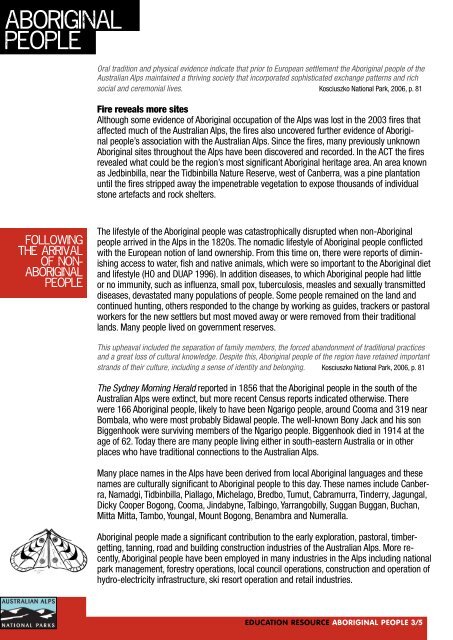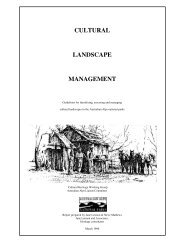Aboriginal People and the Australian Alps (pdf)
Aboriginal People and the Australian Alps (pdf)
Aboriginal People and the Australian Alps (pdf)
Create successful ePaper yourself
Turn your PDF publications into a flip-book with our unique Google optimized e-Paper software.
aboriginalpeopleOral tradition <strong>and</strong> physical evidence indicate that prior to European settlement <strong>the</strong> <strong>Aboriginal</strong> people of <strong>the</strong><strong>Australian</strong> <strong>Alps</strong> maintained a thriving society that incorporated sophisticated exchange patterns <strong>and</strong> richsocial <strong>and</strong> ceremonial lives. Kosciuszko National Park, 2006, p. 81Fire reveals more sitesAlthough some evidence of <strong>Aboriginal</strong> occupation of <strong>the</strong> <strong>Alps</strong> was lost in <strong>the</strong> 2003 fires thataffected much of <strong>the</strong> <strong>Australian</strong> <strong>Alps</strong>, <strong>the</strong> fires also uncovered fur<strong>the</strong>r evidence of <strong>Aboriginal</strong>people’s association with <strong>the</strong> <strong>Australian</strong> <strong>Alps</strong>. Since <strong>the</strong> fires, many previously unknown<strong>Aboriginal</strong> sites throughout <strong>the</strong> <strong>Alps</strong> have been discovered <strong>and</strong> recorded. In <strong>the</strong> ACT <strong>the</strong> firesrevealed what could be <strong>the</strong> region’s most significant <strong>Aboriginal</strong> heritage area. An area knownas Jedbinbilla, near <strong>the</strong> Tidbinbilla Nature Reserve, west of Canberra, was a pine plantationuntil <strong>the</strong> fires stripped away <strong>the</strong> impenetrable vegetation to expose thous<strong>and</strong>s of individualstone artefacts <strong>and</strong> rock shelters.following<strong>the</strong> arrivalof nonaboriginalpeopleThe lifestyle of <strong>the</strong> <strong>Aboriginal</strong> people was catastrophically disrupted when non-<strong>Aboriginal</strong>people arrived in <strong>the</strong> <strong>Alps</strong> in <strong>the</strong> 1820s. The nomadic lifestyle of <strong>Aboriginal</strong> people conflictedwith <strong>the</strong> European notion of l<strong>and</strong> ownership. From this time on, <strong>the</strong>re were reports of diminishingaccess to water, fish <strong>and</strong> native animals, which were so important to <strong>the</strong> <strong>Aboriginal</strong> diet<strong>and</strong> lifestyle (HO <strong>and</strong> DUAP 1996). In addition diseases, to which <strong>Aboriginal</strong> people had littleor no immunity, such as influenza, small pox, tuberculosis, measles <strong>and</strong> sexually transmitteddiseases, devastated many populations of people. Some people remained on <strong>the</strong> l<strong>and</strong> <strong>and</strong>continued hunting, o<strong>the</strong>rs responded to <strong>the</strong> change by working as guides, trackers or pastoralworkers for <strong>the</strong> new settlers but most moved away or were removed from <strong>the</strong>ir traditionall<strong>and</strong>s. Many people lived on government reserves.This upheaval included <strong>the</strong> separation of family members, <strong>the</strong> forced ab<strong>and</strong>onment of traditional practices<strong>and</strong> a great loss of cultural knowledge. Despite this, <strong>Aboriginal</strong> people of <strong>the</strong> region have retained importantstr<strong>and</strong>s of <strong>the</strong>ir culture, including a sense of identity <strong>and</strong> belonging. Kosciuszko National Park, 2006, p. 81The Sydney Morning Herald reported in 1856 that <strong>the</strong> <strong>Aboriginal</strong> people in <strong>the</strong> south of <strong>the</strong><strong>Australian</strong> <strong>Alps</strong> were extinct, but more recent Census reports indicated o<strong>the</strong>rwise. Therewere 166 <strong>Aboriginal</strong> people, likely to have been Ngarigo people, around Cooma <strong>and</strong> 319 nearBombala, who were most probably Bidawal people. The well-known Bony Jack <strong>and</strong> his sonBiggenhook were surviving members of <strong>the</strong> Ngarigo people. Biggenhook died in 1914 at <strong>the</strong>age of 62. Today <strong>the</strong>re are many people living ei<strong>the</strong>r in south-eastern Australia or in o<strong>the</strong>rplaces who have traditional connections to <strong>the</strong> <strong>Australian</strong> <strong>Alps</strong>.Many place names in <strong>the</strong> <strong>Alps</strong> have been derived from local <strong>Aboriginal</strong> languages <strong>and</strong> <strong>the</strong>senames are culturally significant to <strong>Aboriginal</strong> people to this day. These names include Canberra,Namadgi, Tidbinbilla, Piallago, Michelago, Bredbo, Tumut, Cabramurra, Tinderry, Jagungal,Dicky Cooper Bogong, Cooma, Jindabyne, Talbingo, Yarrangobilly, Suggan Buggan, Buchan,Mitta Mitta, Tambo, Youngal, Mount Bogong, Benambra <strong>and</strong> Numeralla.<strong>Aboriginal</strong> people made a significant contribution to <strong>the</strong> early exploration, pastoral, timbergetting,tanning, road <strong>and</strong> building construction industries of <strong>the</strong> <strong>Australian</strong> <strong>Alps</strong>. More recently,<strong>Aboriginal</strong> people have been employed in many industries in <strong>the</strong> <strong>Alps</strong> including nationalpark management, forestry operations, local council operations, construction <strong>and</strong> operation ofhydro-electricity infrastructure, ski resort operation <strong>and</strong> retail industries.EDUCATION RESOURCE ABORIGINAL PEOPLE 3/5
















